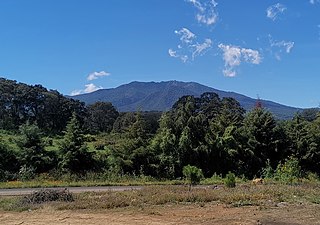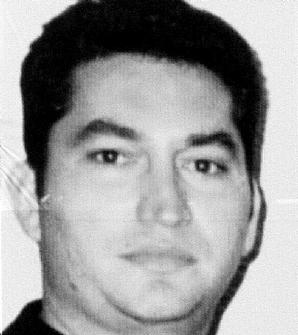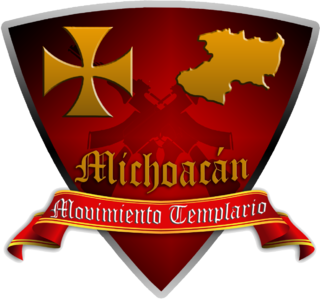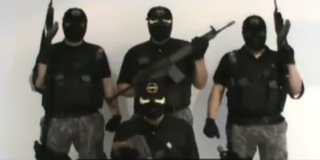Related Research Articles

Michoacán, formally Michoacán de Ocampo, officially the Free and Sovereign State of Michoacán de Ocampo, is one of the 31 states which, together with Mexico City, compose the Federal Entities of Mexico. The state is divided into 113 municipalities and its capital city is Morelia. The city was named after José María Morelos, a native of the city and one of the main heroes of the Mexican War of Independence.
Tepalcatepec, also known as Tepeque, is a city and municipality in the state of Michoacán, Mexico, in the southwestern Tierra Caliente region of the state. The municipality borders the state of Jalisco to the north and west.

Operation Michoacán is a joint operation by Federal Police and the Mexican military to eliminate drug plantations and to combat drug trafficking. Initiated on December 11, 2006, the operation was supervised by The Secretary of Public Safety, Attorney General of Mexico, Secretary of the Interior, Mexican Navy and Mexican Army.
The timeline of some of the most relevant events in the Mexican drug war is set out below. Although violence between drug cartels had been occurring for three decades, the Mexican government held a generally passive stance regarding cartel violence through the 1980s and early 2000s.

Nazario Moreno González, commonly referred to by his aliases El Chayo and El Más Loco, was a Mexican drug lord who headed La Familia Michoacana before heading the Knights Templar Cartel, a drug cartel headquartered in the state of Michoacán. He was one of Mexico's most-wanted drug lords.
The Milenio Cartel, or Cártel de los Valencia, was a Mexican criminal organization based in Michoacán. It relocated to Jalisco in the early 2000s. The Jalisco New Generation Cartel was born from the splintering of the Milenio Cartel.

The Knights Templar Cartel was a Mexican criminal organization originally composed of the remnants of La Familia Michoacana drug cartel based in the Mexican State of Michoacán.

Cárteles Unidos, also known as La Resistencia is a Mexican criminal enforcer squad composed of well-trained gunmen from the Sinaloa Cartel, Gulf Cartel, La Familia Michoacana, and Knights Templar Cartel originally formed to expel the Los Zetas Cartel from the states of Michoacán and Jalisco. However, Cárteles Unidos' current main rival has now become the Jalisco New Generation Cartel; a paramilitary criminal organization based in the neighboring state of Jalisco.

The Jalisco New Generation Cartel or CJNG, is a Mexican criminal syndicate, based in Jalisco and headed by Nemesio Oseguera Cervantes. The cartel has been characterized by extreme violence and public relations campaigns. Though the CJNG is known for diversifying into various criminal rackets, drug trafficking remains its most profitable activity. The cartel has been noted for cannibalizing some victims during the training of new sicarios or members, as well as using drones and rocket-propelled grenades to attack enemies.

Los Ántrax is a large enforcer unit and hit squad for the Sinaloa Cartel, a major crime syndicate based in the Mexican state of Sinaloa. The group was led by the drug lords Jesús Peña, José Rodrigo Aréchiga Gamboa, René Velázquez Valenzuela, among others, and they are responsible for a number of homicides and for providing armed security services to Ismael El Mayo Zambada. The gang operates in the capital city of Culiacán, Sinaloa, where its members conduct homicides and violent attacks. Los Antrax is the Sinaloa Cartel's largest and deadliest enforcer unit.

Grupos de autodefensas or Policía Comunitaria or Policía Popular are vigilante self-defense groups that arose in the Gulf of Mexico and South Mexico regions between 2012 and 2013. The Mexican government has attempted to monitor and absorb these groups into the federal government to act as Rural Police in order to avoid clashes between the paramilitaries and the Mexican Armed Forces itself.
Nemesio Rubén Oseguera Cervantes, commonly referred to by his alias El Mencho, is a Mexican drug lord and leader of the Jalisco New Generation Cartel (CJNG), an organized crime group based in Jalisco. He is the most wanted person in Mexico and one of the most wanted in the U.S. The US government and the Mexican government are offering rewards of US$10 million and MXN$30 million, respectively, for information leading to his arrest.

On 6 April 2015, a convoy of the Jalisco State Police was ambushed by suspected members of the Jalisco New Generation Cartel (CJNG), a criminal group based in Jalisco. The attack occurred in a mountain road in San Sebastián del Oeste, Jalisco. Fifteen policemen were killed and five were wounded; no CJNG casualties were confirmed. According to police reports, as the police convoy reached a part of the road surrounded by mountains, the CJNG opened fire at the police units from the sides using high-caliber rifles, grenade launchers, and explosives with gasoline. The element of surprise prevented the police from repelling the aggression. The CJNG members burned several vehicles along the highway to halt reinforcements. The attack lasted roughly 30 minutes. When government reinforcements reached the scene, the CJNG gunmen had left.

On 19 March 2015, a convoy of the National Gendarmerie, a subdivision of the Mexican Federal Police (PF), was ambushed by gunmen of the Jalisco New Generation Cartel (CJNG), a criminal group based in Jalisco, Mexico. The attack occurred in a residential neighborhood in Ocotlán, Jalisco. Five policemen, four CJNG gunmen, and two civilian bystanders were killed. According to police reports, as the PF convoy pulled up next to a parked vehicle, gunmen shot at them from the vehicle and from rooftops. The police attempted to shield themselves using their patrol cars, but reinforcements from the CJNG arrived at the scene and overwhelmed them. The shootout lasted between thirty minutes to two hours before the CJNG fled the scene.

Martín Arzola Ortega, commonly referred to by his alias "El 53", was a Mexican convicted drug lord and former high-ranking leader of the Jalisco New Generation Cartel (CJNG), a criminal group based in Jalisco. He worked under Nemesio Oseguera Cervantes, the alleged top leader of the CJNG. Arzola Ortega began his criminal career in 1998 as a cargo truck thief and eventually joined the Milenio Cartel, the predecessor group of the CJNG. After several of his bosses were arrested and/or killed, he founded the CJNG with other defectors in the 2010s.
On August 8, 2019, Mexican authorities confirmed the discovery of 19 bodies in Uruapan, Michoacán. The Jalisco Nueva Generación Cartel, through narcomantas, claimed responsibility for the massacre, whose bodies were abandoned in three parts of the city. Six of the bodies found were hung on a vehicular bridge and others were found dismembered.
The Santa Rosa de Lima Cartel or CSRL is a Mexican criminal organization from the state of Guanajuato. Founded in 2014, it was initially headed by "The Sledgehammer". They mainly earn their income from oil theft. In June 2020, it was reported that state government raids and turf wars with the Jalisco New Generation Cartel resulted in the Santa Rosa de Lima losing much of their territories in Guanajuato, Querétaro and Hidalgo and all of their "soldiers." However, cartel members still maintain a small presence in certain municipalities of Guanajuato, such as Celaya, Santa Rosa de Lima, Irapuato, Apaseo, San Miguel Octopan, Cortazar, Salamanca, Villagrán, they are active in organized crime. Ortiz was captured by state and federal authorities on 2 August 2020 along with 5 other people.
Pueblos Unidos is a Mexican criminal group active in the Michoacán region. It began in 2021 as a self-defense group defending the local avocado farmers from cartel gangs Los Viagras and Jalisco New Generation but soon degenerated into a criminal racketeering group itself. It has been suggested that the group is tied to the gang La Resistencia.
On February 3, 2020, suspected CJNG cartel members shot up an arcade in Uruapan, Michoacán, Mexico, killing nine people, including three children.
References
- ↑ "Carteles Unidos Part 1". August 2021.
- ↑ Kryt, Jeremy (12 March 2016). "Meet the Warlord of the Viagras, Mexico's Hardest Cartel Yet". The Daily Beast.
- ↑ "Viagras: former self-defense force battles the Jalisco cartel over Michoacán". 9 August 2019.
- ↑ "¿Quiénes son los Viagras?". La Silla Rota. 13 April 2016. Retrieved 2 May 2020.
- ↑ Kryt, Jeremy (20 October 2019). "The Murderous Mexican Super-Cartel Winning 'Narco Game of Thrones'". The Daily Beast– via www.thedailybeast.com.
- ↑ "Cae en Tierra Caliente jefe de sicarios de "Los Viagras"". El Universal. 7 February 2016.
- ↑ Oliveira, Nelson (4 February 2020). "Gunmen open fire inside video game arcade in Mexico, killing 9, including 3 kids". nydailynews.com.
- 1 2 3 "Why the Jalisco Cartel Does Not Dominate Mexico's Criminal Landscape". 11 June 2020.